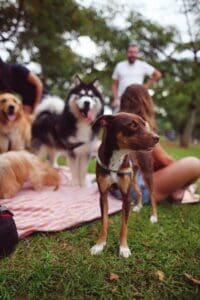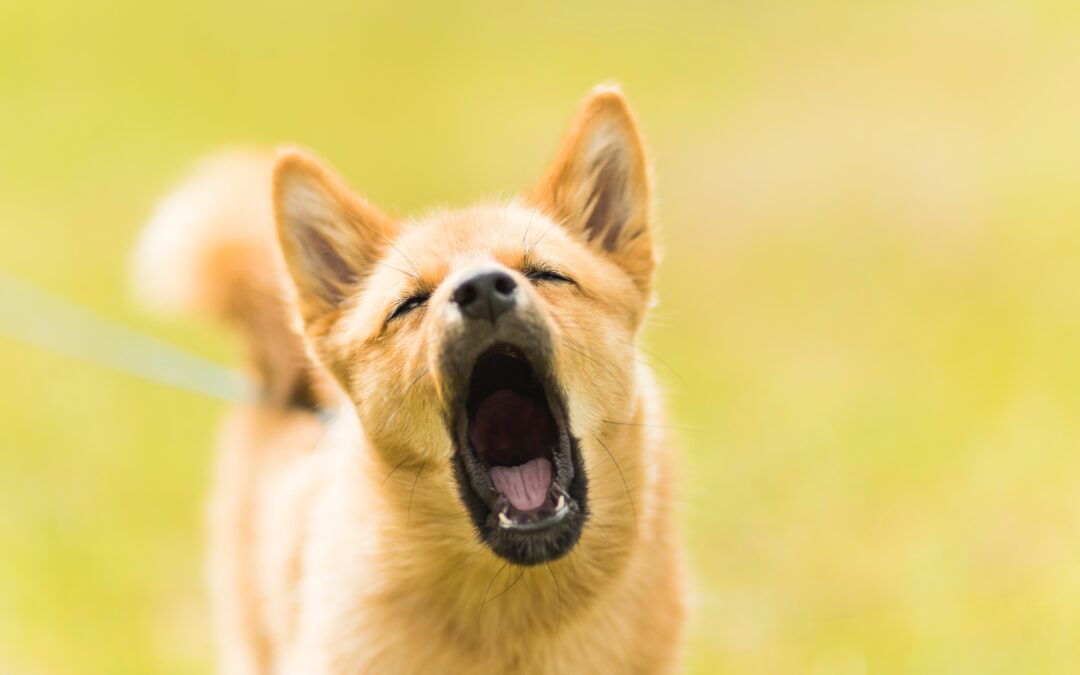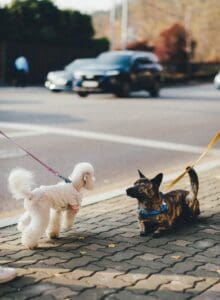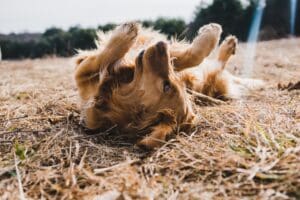At Off Leash K9 Training Northeast, we often hear from our clients about the challenges they face with their dogs’ reactivity. Reactivity is a widespread concern among our furry friends and can happen from various triggers. Countless dog owners dream of their furry companions achieving the remarkable feat of being able to become off leash and display impeccable obedience. To make this vision a reality, Off Leash K9 Training is here to lend a helping hand and guide you and your beloved pup through any challenges you might be facing. Join us on this blog to dive into the concept of reactivity, uncover the reasons behind it, and effective strategies to tackle this issue head-on.
What is Dog Reactivity?
People often mistake dog reactivity for aggression. However, these two concepts are not identical, though they can be linked! Aggressive behavior is all about creating distance; the dog is essentially attempting to create space between them and a perceived threat. In reality, most aggressive behavior stems from fear. For instance, a dog may exhibit aggression when resource guarding a valuable item such as food or a toy, and someone tries to take it away. Dogs may also act aggressively when they feel unsafe, such as when a stranger intrudes into their personal space. Just like humans, aggressive behavior in dogs can also be connected to pain. So, if your furry friend occasionally growls, it doesn’t automatically mean you have an aggressive dog.
Dogs express their desires for things through communication. However, issues arise when a dog displays aggressive behaviors like lunging, displaying their teeth, or biting. It is important to note that dog reactivity does not necessarily indicate an aggressive intent. Similar to humans, dogs instinctively react to their surroundings. At times, their reactivity stems from excitement, such as encountering a new acquaintance or toy. In fact, your beloved canine friend might be so eager to engage that they resort to barking and lunging out of frustration, unable to access the desired person or object immediately. There are instances where dogs exhibit defensive reactions due to sensing a potential threat. Dog reactivity typically surfaces as an exaggerated response triggered by anxiety-inducing stimuli. Examples of reactive behaviors encompass barking, lunging, cowering, shaking, whining, yawning, and more.
Why Are Dogs Reactive?
There are many reasons a dog could be reactive. To address a few:
- Fear: Numerous dogs develop reactive behavior due to a sense of fear. This may stem from apprehension towards other canines, humans, or even inanimate items.
 Lack of Socialization: Dogs who do not have the opportunity to interact with different individuals, creatures, and surroundings during their crucial socialization phase might develop a tendency to react strongly later on in their lives.
Lack of Socialization: Dogs who do not have the opportunity to interact with different individuals, creatures, and surroundings during their crucial socialization phase might develop a tendency to react strongly later on in their lives.- Past Trauma: Previous traumatic experiences can influence dogs to react unfavorably towards certain triggers, such as other canines or humans, when they grow older.
- Territorial Behavior: Dogs that are protective of their territory, such as their home or yard, may become reactive towards people or animals that enter their space.
What Are Common Triggers for Reactive Dogs?
Common triggers for reactive dogs include:
- Loud vehicles like trucks, motorcycles, sports cars
- People with medical equipment, hats, facial hair or piercings – anything your pup was not exposed to when they were a puppy
- Other dogs passing by
- Strangers approaching you or your home (mailman, delivery driver, or guests)
- Barriers like crates or fences that prevent them from going somewhere they want to go
- Being on leash
In certain instances, dogs may bark and lunge because they have a strong desire for something they can’t reach, and this frustrates them. Alternatively, they may feel uneasy and learn that barking and lunging can make the perceived threat vanish. For anxious dogs, acting out reinforces their behavior as they feel relief when the threat disappears. To them, it’s a straightforward matter of action and consequence. In total, a reactive dog’s enthusiasm and anxiety might lead to displays of aggression. Not addressing this issue could potentially exacerbate the aggression.
Your Dog’s Triggers
A recommended course of action for dog owners is to maintain a log or list documenting their dog’s reactive behaviors. The log should include specific details such as the time, the days of the week, and the circumstances preceding the behaviors. By carefully noting these particulars, owners can more effectively identify the triggers for their dog’s reactions. For instance, some dogs may become particularly alert during rush hour when they hear traffic noises, while others may experience fear during nighttime when their visibility is diminished. For example, older dogs with declining eyesight might become anxious when they hear sounds without being able to see their surroundings. Having this information is essential when seeking assistance from a trainer or professional to address your dog’s reactivity.
How Do We Address Reactivity?
If your dog is reactive, there are numerous measures you can take to assist in tackling the problem:
- Training: In order to effectively tackle any behavioral problem with your dog, it is crucial that they have a clear understanding of your commands. Otherwise, it’s like trying to communicate with someone in a completely foreign language without any background knowledge. By enrolling your furry friend in obedience training and exposing them to different individuals, animals, and surroundings, you can greatly diminish their anxiety levels.
- Counter-Conditioning and Socialization: You have the power to transform your dog’s emotional reaction to specific triggers. If your dog tends to react negatively to other dogs, you can progressively introduce them to other canine friends while offering positive reinforcement like praise or treats once they have achieved a calm and obedient state of mind.
- Desensitization: This involves gradually exposing your dog to their triggers that causes their reactivity, starting at a distance and gradually moving closer after they are brought to a neutral state of mind through obedience. This can help reduce their reaction over time.
Counter-conditioning and desensitization involve a step-by-step approach. You gradually introduce your furry friend to what triggers them, while also giving them rewards that they absolutely love. If you work with a qualified professional, such as a certified dog trainer or behavioral consultant, they can create a personalized plan to transform your dog’s reactive behavior and demonstrate the exact measures for you to follow. Let me provide an illustrative example to help you understand the process better:
- To keep your pup in check during walks, it’s a great idea to always have a treat pouch handy. This way, you’ll be geared up to tackle any sudden lunges towards fellow canines with positive reinforcement.
- Keep an eye on your furry friend and be patient until they spot the approaching dog.
- Once your furry friend catches sight of the other dog, encourage them to sit and begin presenting them with a high value reward as the other dog makes its way past.
- Once the other dog has passed by, stop feeding and continue your walk.
In essence, you are empowering your furry friend to associate the presence of treats with another dog approaching them. This training enables your dog to understand that the presence of other dogs can lead to delicious rewards and that it is beneficial to stay connected with you when another dog is in sight. With consistent dedication and a positive outlook, your cherished companion will gradually grasp the concept that encounters with other dogs can be uneventful and not worth excessive excitement. This newfound realization will help them recognize that the presence of other dogs shouldn’t be considered a significant event!
Can Dog Reactivity Get Better?
Absolutely, dogs have the potential to make significant progress through consistent training and effort. Nevertheless, if a fear-based behavior becomes deeply rooted in a dog, it may persist to some extent. In such cases, you can minimize their reactivity, but you will need to continue managing it throughout their lifetime. This entails ongoing training and dedication to maintaining control over your dog’s reactive tendencies. Transforming your dog’s behavior won’t occur instantaneously, but through patient training, you can anticipate a more composed and self-assured companion.
What Can I Do?
Dog reactivity is one of the most common issues that we encounter with our clients here at Off Leash K9 Training Northeast. Canine reactivity can occur in response to various triggers such as other dogs, people, noises, and objects. By understanding the root causes of your dog’s reactivity and implementing effective training methods, we can help diminish their reactive behaviors and enhance their overall conduct. The first vital step to take is obedience training. At Off Leash K9 Training, we provide comprehensive obedience lessons and board and train programs that aim to instill self-confidence in your furry friend, enabling them to confront their fears and create a future free from reactivity. Feel free to reach out to us today for a complimentary phone consultation with one of our skilled trainers. We are eager to discuss your dog’s reactivity and how our services can assist them.
We invite you to explore our YouTube channel, where you’ll find countless videos featuring the amazing progress we’ve achieved with numerous dogs in conquering their reactivity and fostering obedience.




